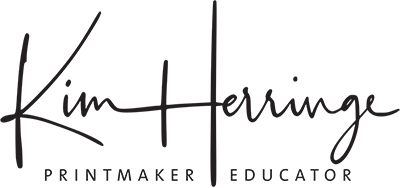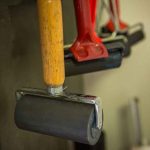Part 2: The Art of Printmaking
In Part 2 of this 3 part series I continue to share with you information prepared by the Maleny Printmakers and Sonja Georgeson that works to explain and demystify the art of Printmaking. In this article I share different types of printmaking; different printmaking methods.
It is not a complete list, so if you think I have forgotten something please share it in the comments below. That will help the Maleny Printmakers in their efforts to reignite the craft and help educate art lovers of the value and craft of printmaking. Missed Part 1: What is Printmaking?
Relief Printmaking
In relief printing, ink is kept in place because certain areas of the block are carved away, leaving other areas raised or standing in relief. The printmaker rolls ink onto the block by means of a roller, called a brayer, that distributes the ink onto the raised or relief parts of the block. The carved away parts don’t touch the brayer, so they don’t get inked.
Finally, the artist presses a flat material to the block, such as paper, and the ink is offset onto it, producing a reversed image of the design that was carved onto the block. Pressing can be done by burnishing (or pressing) with various implements including wooden spoons and specially made burnishing tools called barens, or by means of a printing press. The artist then repeats the inking process for as many prints as he or she wants to make.
Examples of relief printmaking are:
- linocut,
- woodcut,
- wood engraving and
- collagraph.
Intaglio Printmaking
In intaglio printing, lines or tones are engraved or etched into the surface of a plate or block. The plate is inked and then wiped, leaving the grooves filled with ink and the surface clean. Soft dampened paper is laid over the plate, and both paper and plate are put through the rollers of an etching press. The pressure of the rollers forces the paper into the grooves, so that it takes up the ink, leaving an indented impression of the whole plate on the paper (a plate mark).
Examples of intaglio printmaking are:
- engraving,
- etching,
- dry point,
- mezzotint,
- soft ground,
- aquatint, collagraph and
- sugar lift.
The different types of printmaking methods
Monotype
An intriguing hybrid among printmaking techniques is MONOTYPE. It is a combination of painting and printmaking. One image (mono) is painted or drawn with oil paint, water-based paint, or printer’s ink directly on a plate and then transferred to paper. Metal plates, plastic sheets, glass, wood or any surface, even gelatine, that will transfer an image onto paper, can be used. The impression can be transferred by hand rubbing or printed on a press.
MONOTYPE and MONOPRINT
Monotype – a one-of-a-kind print made by painting on a smooth metal, glass, gelatin or stone plate and then printing on paper. The pressure of printing creates a texture not possible when painting directly on paper.
Monoprint – one of a series in which each print has some differences of colour, design, texture, etc. applied to an underlying common image.
Linocut or Linoprint
Linocut is one of the most widely known and used forms of relief printing. A sheet of lino or vinyl is used for a block or plate and it is the raised surface containing the positive image that is printed. The background area or negative space is carved away, creating the white, or nonprinting, areas. As with other relief prints (woodcut and engraving) ink is applied with a roller to the raised surface, paper placed on it, and the image transferred by rubbing the back of the paper with a wooden spoon or baren or by running the block and paper through a press. The resulting prints can be hand-coloured or multiple blocks can be carved, each to be inked in a single colour and accurately registered (lined up) and printed one on top of the other to create multi-coloured prints.
Reductive Linocut/Linoprint
This is also known as the “suicide method”, because there is no going back. A single block is used and is progressively carved away. Once the first colour has been inked over the entire block and the required number of registered prints has been taken, the sections of the block which correspond to that initial colour are cut away. Then the next colour is printed over the first and again the relevant areas are removed. Inking, printing and cutting continue in this pattern until all the colours have been printed. After the final printing the much-reduced block can be thrown away.
Lino Etching
Linoleum can be etched with caustic soda (sodium hydroxide) and printed as either a relief print or an intaglio print. Various resists, such as etching ground, asphaltum, heated paraffin wax, or varnish, can be painted on the block and later scratched into or incised. The caustic soda is brushed or swabbed onto the lino and replenished as it loses strength. Deep biting takes some time.
Etching
In etching, the lines are scratched through an acidresist ground, then bitten into the surface of the plate by acid. During the process, surface areas that need to be protected from the corrosive action of the acid are covered with a thin film of resist. This is a wax-like substance that can be hard or soft depending on the type of image required and the technique. It is known as the “ground”. The edges and the back of the plate are protected from the acid with varnish. An etching needle is used to draw the image into the ground, exposing the metal in those areas.
The plate is then placed in a diluted acid bath and the exposed metal is etched. The plate can be removed at any time, and the action of the acid on certain lines can be stopped by painting over them with stopping-out varnish. Once the lines have been etched sufficiently deeply, the plate is taken out of the acid, the ground and varnish removed, and the plate is inked up. An impression is then taken by passing the plate, together with overlaid dampened paper, through the etching press.
Drypoint
Is the most direct of the intaglio processes. The technique consists of scratching into the surface of a metal plate using a strong, sharp point. This causes a ridge of metal – called the burr – to be thrown up on one or both sides of the line. This burr catches and holds the ink when it is wiped yielding a rich, soft line and contributes a velvety quality to the impression.
Drawing on the plate with the point is directly comparable to drawing on paper, though sufficient pressure must be used to mark the metal effectively.
Collagraph
Collagraph prints are taken from plates made as a collage of different textured materials. The base plate can be almost any sheet substrate – cardboard, mountboard, hardboard, MDF or thin plywood, metal or plastic. A unique textured collage image is created on the plate by applying or gluing down many possible materials – glues, acrylic paints and (textured) mediums, sandpaper, cardboard, card, textiles, papers, tissue, bubble wrap, string, fibres, leaves, plants, wax, plaster, (found) flat object. The list goes on.
Surfaces can also be scratched and carved into to create more marks. The finished plate is varnished with shellac, looks like a shallow relief collage, and is interesting in its own right. The plate can be inked up in many ways – for a relief print with a roller; for an intaglio print by covering with ink and wiping back until the ink only stays in the cracks and around edges; or a combination of both. The collagraph technique is very varied and adventurous. There are endless creative possibilities for plate construction and printing variations.
La Poupee
A French method of inking a single etching plate with many colours. The name derives from the use of a small cloth dabber tied at one end (resembling a doll’s head) to blend many colours on a single plate.
Solar Plate Etching / Photopolymer
Originally a commercial printmaking process it has been taken up by artist printmakers. It involves a light-sensitive, polymer coating on a plastic or metal backing and can make either a relief or an intaglio plate. The plate is exposed to quartz halide or UV light through the artwork on transparent film and washed out with warm water. The result is a photographic relief printing plate.
Chine Collé
A method of adhering thin pieces of coloured paper to the larger printing paper at the time that the inked image is printed. You glue the paper and print the image with one roll through the press.
Aquatint
This technique is used to achieve tonal areas in an intaglio plate. Tones are bitten into the plate after the surface has been partially covered with many particles of rosin (adhered to the plate by heating). The acid bites the open areas around these particles, creating uniform pitting in the plate. The longer the bite, the deeper the pits and the darker the printed tone. Aquatint is most often combined with line etching and other methods.
Digital Archival Print
Using the computer as a medium and inkjet printer as the tool, employing archival or pigment inks and printing onto a archival digital papers or prepared archival surfaces. Print Transfer
A digital print released, usually by rubbing, onto various prepared surfaces.
Cyanotype
Cyanotype is a photographic printing process that produces a cyan-blue print. Engineers used the process well into the 20th century as a simple and low-cost process to produce copies of drawings, referred to as blueprints. The process uses two chemicals: ferric ammonium citrate (green) and potassium ferricyanide.
Ready to read on…
Part 3: Editioning Fine Art Prints
Or want to recap what was previously covered?
Go back to read Part 1: What is Printmaking





